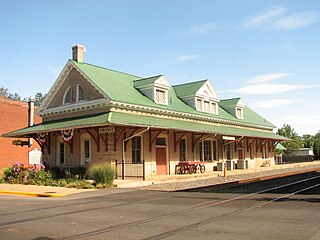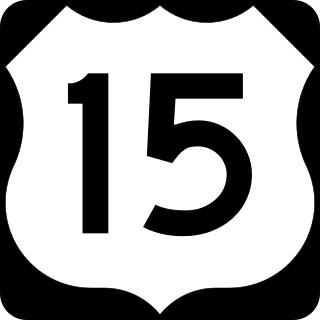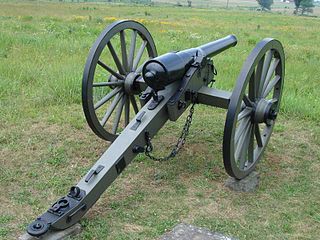
Orange County is a county located in the Central Piedmont region of the Commonwealth of Virginia. At the 2020 census, the population was 36,254. Its county seat is Orange. Orange County includes Montpelier, the 2,700-acre (1,100 ha) estate of James Madison, the 4th President of the United States and often known as the "Father of the Constitution". The county will celebrate its 290th anniversary in 2024.

Culpeper County is a county located along the borderlands of the northern and central region of the Commonwealth of Virginia. As of the 2020 United States Census, the population was 52,552. Its county seat and only incorporated community is Culpeper.

Culpeper is an incorporated town in Culpeper County, Virginia, United States. The population was 20,062 at the 2020 census, up from 16,379 at the 2010 census. It is the county seat of Culpeper County.

Orange is a town and the county seat of Orange County, Virginia, United States. The population was 5,062 at the 2020 census, representing a 7.2% increase since the 2010 census. Orange is 28 miles (45 km) northeast of Charlottesville, 88 miles (142 km) southwest of Washington, D.C., and 4 miles (6 km) east of Founding Father and fourth U.S. president James Madison's plantation of Montpelier.

Gordonsville is a town in Orange County in the Commonwealth of Virginia in the United States. Located about 19 miles northeast of Charlottesville and 65 miles northwest of Richmond, the population was 1,496 at the 2010 census.

The Orange and Alexandria Railroad (O&A) was a railroad in Virginia, United States. Chartered in 1848, it eventually extended from Alexandria to Gordonsville, with another section from Charlottesville to Lynchburg. The road played a crucial role in the American Civil War, saw the first of many mergers in 1867, and eventually became an important part of the modern-day Norfolk Southern rail system.

The Virginia Central Railroad was an early railroad in the U.S. state of Virginia that operated between 1850 and 1868 from Richmond westward for 206 miles (332 km) to Covington. Chartered in 1836 as the Louisa Railroad by the Virginia General Assembly, the railroad began near the Richmond, Fredericksburg and Potomac Railroad's line and expanded westward to Orange County, reaching Gordonsville by 1840. In 1849, the Blue Ridge Railroad was chartered to construct a line over the Blue Ridge Mountains for the Louisa Railroad which reached the base of the Blue Ridge in 1852. After a decision from the U.S. Supreme Court, the Louisa Railroad was allowed to expand eastward from a point near Doswell to Richmond.

The Bristoe campaign was a series of minor battles fought in Virginia during October and November 1863, in the American Civil War. Maj. Gen. George G. Meade, commanding the Union Army of the Potomac, began to maneuver in an unsuccessful attempt to defeat Gen. Robert E. Lee's Army of Northern Virginia. Lee countered with a turning movement, which caused Meade to withdraw his army back toward Centreville. Lee struck at Bristoe Station on October 14, but suffered losses in two brigades and withdrew. As Meade followed south once again, the Union army smashed a Confederate defensive bridgehead at Rappahannock Station on November 7 and drove Lee back across the Rapidan River. Along with the infantry battles, the cavalry forces of the armies fought at Auburn on October 13, again at Auburn on October 14, and at Buckland Mills on October 19.

Buildings, sites, districts, and objects in Virginia listed on the National Register of Historic Places:

U.S. Route 15 (US 15) is a part of the United States Numbered Highway System that runs from Walterboro, South Carolina, to Painted Post, New York. In Virginia, the U.S. Highway runs 230.37 miles (370.74 km) from the North Carolina state line near Clarksville north to the Maryland state line at the Potomac River near Lucketts. US 15 is a major north–south highway through the Piedmont of Virginia, connecting Clarksville and Farmville in Southside with Culpeper, Warrenton, and Leesburg in Northern Virginia.

The Washington Subdivision is a railroad line in Virginia owned by CSX Transportation and leased and operated by the Buckingham Branch Railroad.
Jeremiah Morton was a nineteenth-century politician, lawyer, physician and architect from Virginia. He was a younger brother of Florida senator Jackson Morton.

Rapidan is a small unincorporated community in the Virginia counties of Culpeper and Orange, approximately 5 miles (8 km) northeast of the Town of Orange. The community, located on both sides of the Rapidan River, was established in the late eighteenth century around the Waugh's Ford mill. The Orange and Alexandria Railroad built a line through the town in 1854, a post office was built at the river crossing, and its name was changed to Rapid Ann Station. Milling remained a major industry in the area up through the mid-twentieth century.
Cohasset is an unincorporated community in Fluvanna County, in the U.S. state of Virginia located about two miles west of Fork Union on State Route 6.
The Fast Flying Virginian (FFV) was a named passenger train of the Chesapeake & Ohio Railway.

The Potomac, Fredericksburg, and Piedmont Railroad (PF&P) was a 3 ft narrow gauge short-line railroad in central Virginia that operated between Fredericksburg and Orange, Virginia. It operated until 1926, when its track was sold. A one-mile portion of the former PF&P line continued to be operated as the Virginia Central Railway until the early 1980s. The track has since been removed.

Rapidan Historic District is a national historic district located at Rapidan, in Culpeper County and Orange County, Virginia. It encompasses 34 contributing buildings in the crossroads village of Rapidan. They include three churches, a post office, a commercial building, one meeting hall, two railroad depots, twenty-one residences, and six outbuildings. Notable buildings include the Emmanuel Episcopal Church (1874), "Annandale", the Rapidan Trading Post (1903), Rapidan Post Office (1914), Lower Rapidan Baptist Church (1914), Rapidan Passenger Depot, and the Peyton-Grhby House. Also located in the district is the separately listed Waddell Memorial Presbyterian Church.

The 4th U.S. Artillery, Battery E was an artillery battery that served in the Union Army during the American Civil War. The unit fought at the battles of Kernstown, Port Republic, Rappahannock Station, Second Bull Run, Chantilly, Antietam, and Fredericksburg in 1862. The battery transferred to the Cavalry Corps where it served for the rest of the war. In 1863, 4th U.S. Artillery, Battery E fought at Chancellorsville, Gettysburg, Culpeper, Bristoe Station, and Mine Run. In 1864, the unit fought at the Wilderness, Todd's Tavern, Yellow Tavern, Totopotomoy, Cold Harbor, the Wilson-Kautz Raid, Opequon, Fisher's Hill, and Cedar Creek. In 1865, it saw action at Dinwiddie Court House, Five Forks, Sailor's Creek, and Appomattox before taking part in the Grand Review of the Armies.

The Washington District is a Norfolk Southern Railway line in the U.S. state of Virginia that connects Alexandria and Lynchburg. Most of the line was built from 1850 to 1860 by the Orange and Alexandria Railroad, while a small portion in the center opened in 1880 as the Charlottesville and Rapidan Railroad. Today, the line is mainly used for freight service, but Amtrak's Crescent, Cardinal and Northeast Regional passenger services use all or part of the line, and the Virginia Railway Express Manassas Line commuter service uses the northernmost portion of the line.


















